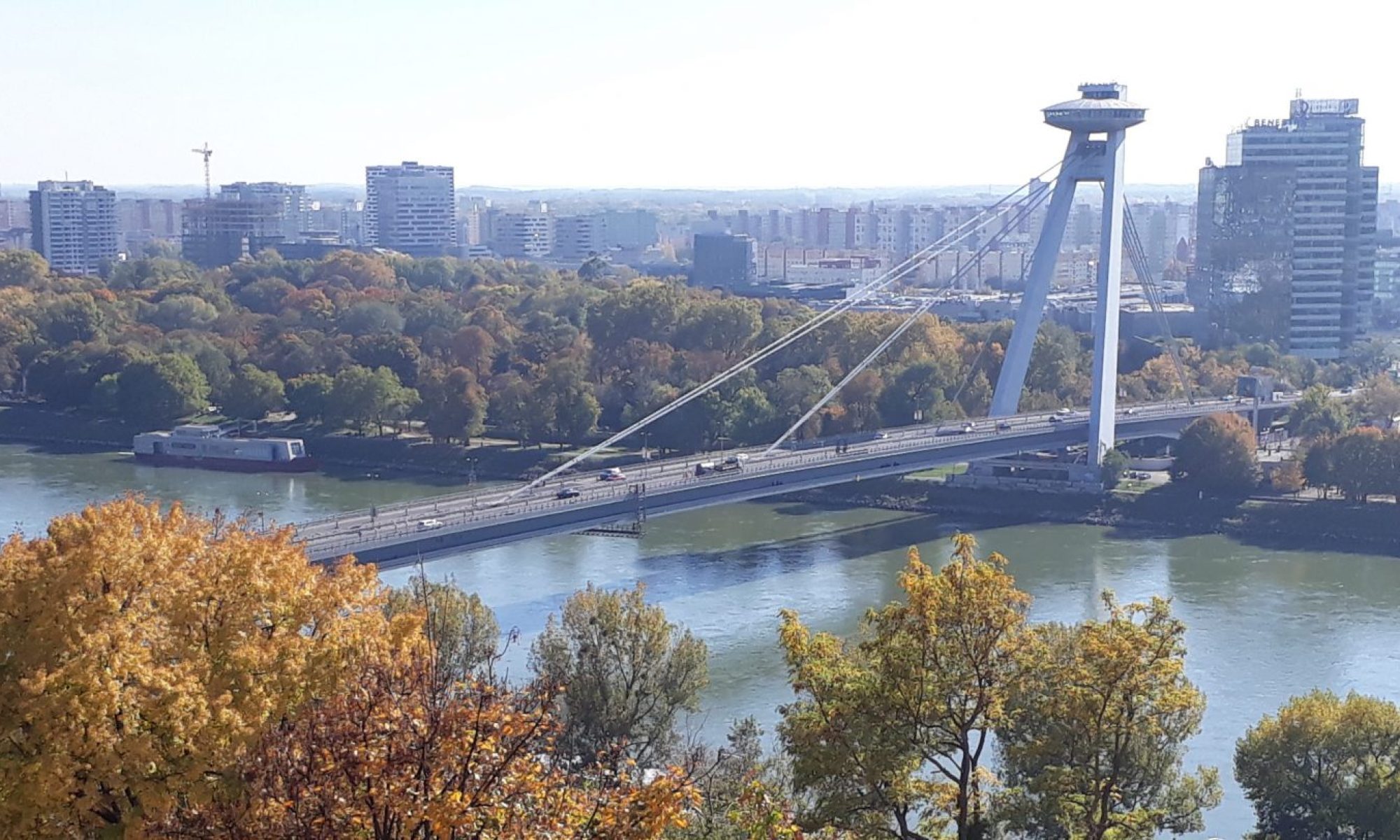“The beauty of chess is it can be whatever you want it to be. It transcends language, age, race, religion, politics, gender, and socio-economic background. Whatever your circumstances, anyone can enjoy a good fight to the death over the chessboard.” (Simon Williams)
In June 2020 I should have travelled on the special 10th running of the Chess Train. As the Covid pandemic swept Europe last year the trip was cancelled and at the moment it is not clear when the Chess Train will run again. So this month’s post will look back of my most recent participation on the Chess Train tournament in October 2019.
Once I had had confirmed my place on the 2019 Chess Train in the spring of that year, I set about making bookings for my travel to Prague. In previous years I had caught a cheap flight from London’s Stansted Airport to the Czech capital. However, I had a shock when I tried to book my usual flight on this occasion. Even though I was booking well in advance, the ticket prices for the outward flight were about four times what I had paid in previous years. Given I normally give myself a spare day in the Czech Republic before the Chess Train departs, I thought if I departed a day later then maybe prices would be more reasonable. But no, they were twice as much again! I then worked out what was going on. England were due to play the Czech Republic in the Euro football qualifying tournament in Prague the day the Chess Train departed and the budget airlines had anticipated the increased demand by jacking up their prices. I contemplated travelling by train all the way from London to Prague, for which I found I could get tickets cheaper than the air fare, but as it is not possible to do it in a single day, it would mean staying overnight in Brussels which would add to the cost. In the end I discovered a reasonably priced flight from London’s City Airport to Prague at about the same time of day as I had previously travelled. City Airport is built on an old dock adjacent to what has now become London’s new financial district, and can only accommodate smaller planes. It caters primarily for the business travel market and consequently flights from City Airport are normally more expensive. However, once I had factored in that it was much cheaper (as well as quicker) for me to travel from my home to City Airport than to Stansted, and also I would need to pay more for a hold bag with a budget airline, and I would get free snacks and drinks on this flight, the cost was actually comparable to that which I had paid in previous years.
Once I had booked my flight, I also booked the hotel I had used on previous occasions via a booking agency to get the best deal. However, the company I had booked with went bust just over a week before I was due to travel and since the hotel had received no money from them, I had to book again directly with the hotel, now at a higher price. So the saving I got from using the booking agency turned out be a false economy. As I had paid by credit card, I eventually did get a refund from my credit card issuer of the money paid to the bankrupt booking agency.
Wednesday 9th October 2019 – London to Prague
It only takes just over 30 minutes to travel from my home to City Airport and, being a business oriented airport, it does not insist on the ridiculously long check-in times suggested by its rivals. So I could leave home mid-morning for my trip to Prague. The main problem I had was that it was the time of the Extinction Rebellion protests in London that week and they were threatening to shut down City Airport on the day after I was due to travel. The authorities were taking no chances when I arrived at the airport. You were only allowed to leave by the airport exit from the DLR station by showing your boarding card and passport at a police checkpoint, then I had to do the same again 50 yards later to enter the airport terminal building.
After dropping off my suitcase to be checked in, I discovered there was a slight delay to my flight, which gave me plenty of time to explore the airport. I noticed that the perimeter of the runway which is surrounded on three sides by water was being patrolled by police to prevent any water-borne invasion by protesters. My plane was only slightly late arriving and a quick turnaround got us nearly back on schedule. After taking off the plane did a big circular sweep round East London, such that I was able to see my house from the plane, the first time that I have ever managed to do that. The flight to Prague was uneventful, the free drinks and snacks were welcome, but the food was rather less substantial than I had been anticipating, being just a choice of nibbles.
In 2019, I had acquired an Irish passport for the first time, as technically I have been an Irish, as well as a British, citizen since birth. I hoped this would ease any post-Brexit travel difficulties. I had read that if you travel with two passports you need to be careful to ensure that you use the same one when entering and leaving the Schengen Area, otherwise you could have problems when you next try to enter. As I had given my Irish passport details to the airline, I needed to use that one to operate the e-gates at Prague airport on arrival. Prague airport was as efficient as it usually was and the whole process was very quick. While waiting a short while for my bag to be delivered, I noticed that the adjacent baggage carousel was for the flight from Stansted that I had caught in previous years and that there were a number of football supporters wearing England shirts waiting there. These were the only England supporters I saw during my whole trip. Unfortunately, the machine selling public transport tickets by the baggage reclaim was not working – it usually saves a bit of time to buy your transport tickets while waiting for your bag to be delivered. When I got into the main terminal, I saw that the 119 bus I needed was waiting, but a Russian couple ahead of me didn’t understand how to use the ticket machine, so by the time they gave up trying and let me show them how to buy tickets, the bus had gone. It was not a problem, as another one came along shortly.
The bus and metro trip to the hotel I had used for the previous two years was now familiar. I arrived at the hotel mid-afternoon, the receptionist seemed to remember me from my previous visits, which was impressive, and I was allocated a spacious double room even though I had only paid for a single.
In the evening I visited again the bar/restaurant about a mile from my hotel in the Vyšehrad area of the city that I had discovered for the first time the previous year. This time there were no incidents with dogs. I had an interesting Olomouc cheese starter followed by pork schnitzel all washed down with several beers.
Thursday 10th October 2019 – Day trip to Kutná Hora
For my spare day before the Chess Train departed I decided to take a trip to Kutná Hora, an old city just over an hour by train from Prague. It was somewhere I had wanted to go since my son had told me about a visit he had made there and my frequent visits to Prague meant that I was beginning to run out of new places to visit in the capital. I also wanted to minimise my chances of encountering any English football supporters – that aim succeeded totally, I did not see any all day.
I caught a train from Praha hlavní nádraží just after 9am, which would require a couple of changes at Kolín and Kutná Hora hlavní nádraží, before arriving at Kutná Hora město station at about 10:30am. I had bought my ticket in advance on-line and I was using the České Dráhy app on my phone to store it – the app made an old train whistle sound to notify me of any developments, such as the need to change trains. The second train of my journey was delayed, but fortunately the small rail car which shuttles from the main station at the junction to Kutná Hora town waited for the connection.
I walked from the small station to the centre of the town. Kutná Hora was an old silver mining town where the Bohemian Royal Mint had been located in medieval times. My first stop was the Italian Court, the home of the mint and named after the craftsmen from Florence who were brought in by Wenceslas II to run it originally. When I arrived I booked a guided tour for 11am. At 11am I was was the only person waiting for a tour, so I had an exclusive comprehensive tour to myself, which went all over the site, including visiting the royal chapel and the mint itself. I got the chance to press a silver Thaler, to keep as a memento, though the blank disc I pressed was actually made of aluminium.
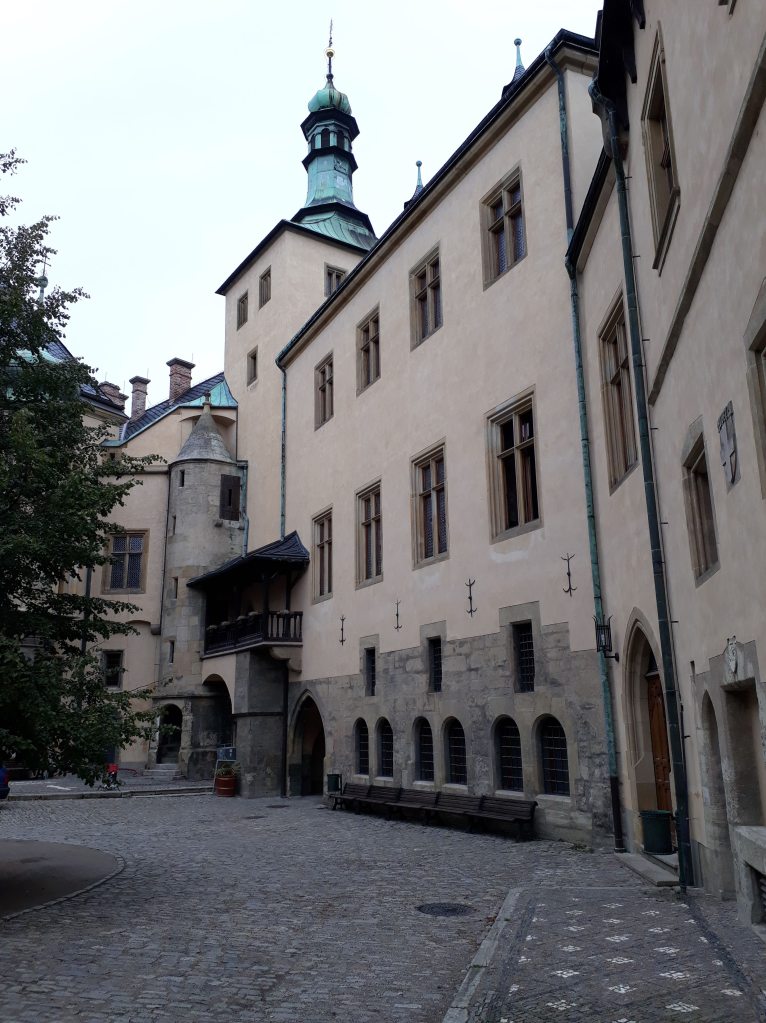
After about an hour exploring the Italian Court, I went to the Tyl House, a small museum of local history and geology, which had once been the home of Josef Kajetán Tyl, a nineteenth playwright and author who wrote the words to the Czech national anthem. As there were only three small rooms to see, the Tyl House did not detain me long.
Next stop was the Dacicky House an interactive exhibition showcasing all UNESCO World Heritage Sites in the Czech Republic. Surprisingly there are 14 World Heritage Sites in the country and the Dacicky House had displays about all of them.
From the Dacicky house I walked to St Barbara’s Cathedral, a massive Gothic church on one side of a steep valley. Part way there, the heavens opened and it started to rain hard. At the time, I was directly outside the modern art gallery and I contemplated going inside to seek shelter, but I remembered that my son had reported a not very favourable view of the place, so I decided to give it a miss and pressed on at speed to St Barbara’s to try to avoid getting too wet. You can walk round the church at two levels – as well as the the main nave you can climb up to a gallery level and look down into the body of the church.
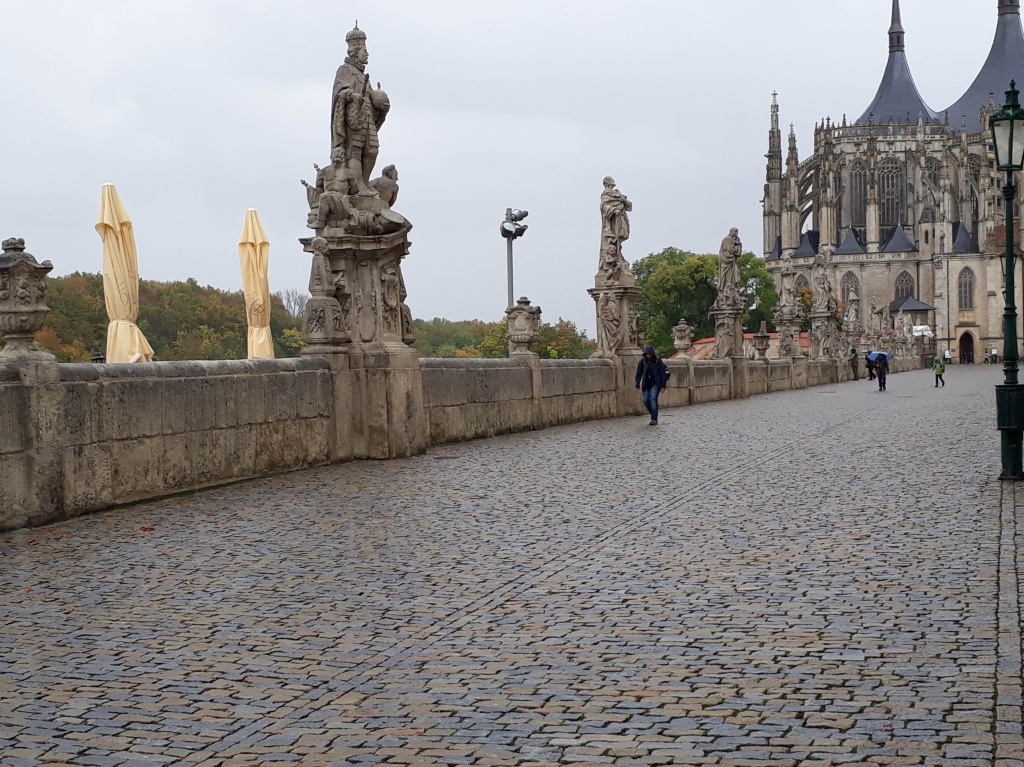
When I left the cathedral it had stopped raining and the sun was coming out. I made my way to the Museum of Silver, where I had made an on-line booking a few days earlier for a tour of a silver mine. The booking system was unusual – if nobody else had yet booked a particular time slot you could choose the language for the tour (at the time I booked it gave a choice of Czech, English or French). But by having booked an early afternoon tour in English, it then blocked out English as choice for the language for the tour before and after it. When I got there, I checked in and deposited my bag, as due to the narrow passages, no bags are allowed in the mine. I had a little time before the tour was due to begin, so I made a start of looking round the museum describing the history of silver mining in the area. When the due time came, there was a small group of about eight people waiting to go down the mine. We were first taken to a small cave entrance with a few steps, to test how we would cope with with the claustrophobia and climbs of the real mine. Having convinced our guide that we would cope we were taken to be kitted out in overalls, helmets and lamps, before going on a short walk to the mine entrance. We descended stairs which had been installed in a deep shaft to the dimly lit mine, which was damp and very narrow in places. Normally you would follow a linear route which would bring you to an exit back at the museum, but at the time of my visit this was being renovated so we had to return the way we came in. When we were in the furthest part of the mine the guide turned off all the lights, so we could get a sense of the darkness in which the miners would have operated.
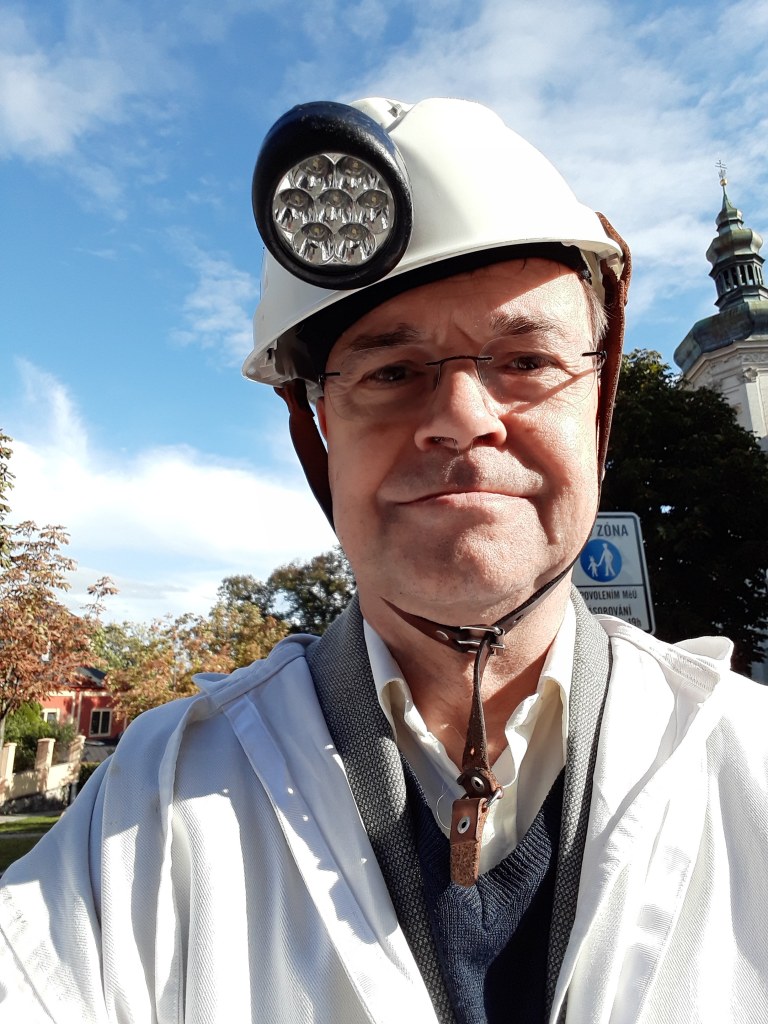
Once I had returned to the surface and had got my breath back from the steep climb, I went back to the silver museum to continue looking at the exhibits.
After the Silver Museum I went to the Stone House, another museum nearby. As is the custom for many Czech museums you could pay for just those galleries you wished to look at. I paid to visit the whole museum. The most interesting were upstairs where there were exhibitions describing city life in Kutná Hora between the 17th and 19th centuries. In the basement was an exhibition of carved stonework, while on the ground floor was a temporary exhibition of glassware. I finally finished at about the closing time of the Stone House.
I decided to have an early dinner in Kutná Hora , partly because I thought it would be cheaper than in Prague and also to avoid any England football supporters. From the reviews I read on my phone, I chose a pub down a side-street a short distance from the centre of the town. When I got there there were no external windows, so I could not look in, and no menu on display outside – just a notice by the door, which I translated as saying that a woman was required for the kitchen. I decided to risk it and went inside. I ordered what was described as meat with cheese and bread for starter, followed by grilled chicken with fried potatoes. The starter, which I expected to be just a small plate of cold meat and cheese, turned out to be a hot beef stew topped with melted cheese served on a bed of toast. It was a very substantial meal in itself. While I was there I realised that I was about to run out of charge on my phone, and was observed looking for electrical sockets in the bar, but there were none, so my phone was taken to the kitchen to be recharged while I finished my meal. The friendly server also ensured that I did not run out of beer during my meal.
I finally dragged myself from the bar and, feeling very full, made my way to Kutná Hora mesto station to catch the 18:45 departure. Shortly after I alighted, and found a seat in an empty compartment at the front of the train, I was joined by four very cheeky children, who tried to strike up a conversation with me. When they realised that I could not speak Czech, they practised their English, telling me their names and that they were aged 12, 11, 10 and 5! The child age 11 was a girl, the other three were boys. They were fascinated by my Czech – English phrasebook and wanted to read out bits of it for me, thinking that my attempts at Czech pronunciation were hilarious. They appeared to be travelling unaccompanied and when we reached the junction station where I was to change for my train to Prague, I last saw them skipping away from the station and into the night. This was the only change I needed to make on the return journey and my train to Prague was on time, reaching the capital at 8pm. I went from the station to my hotel and decided to have an early night in preparation for my early start the next day.
Friday 11th October 2019 – Prague to Karlovy Vary
As in previous years, the Chess Train kicked off with a breakfast and opening ceremony in the Government Lounge at Prague’s main railway station. Over breakfast, I got to say hello to many familiar faces from my previous two trips on the Chess Train. The opening ceremony this year was graced by the presence of two Czech Government cabinet ministers – Tomáš Petříček, the Czech Foreign minister, and Vladimír Kremlík, the Transport minister. Consequently, there was also a turnout from the top brass of the various parts of Czech Railways. Kremlik seemed a bit of a joker – he gave a long speech, which he used to troll the assembled railway officials about the delivery date for various projects and he also interrupted them when they were giving their remarks. Petříček was far more measured and statesmanlike – he explained that his young daughter was a chess player and that he hoped to accompany her on the 2020 Chess Train. (In a strange co-incidence, at the same time exactly one week later when I was back in the UK, I was listing to the BBC Radio morning news programme and they had an interview with Petříček talking about the then latest phase of the interminable Brexit negotiations.)
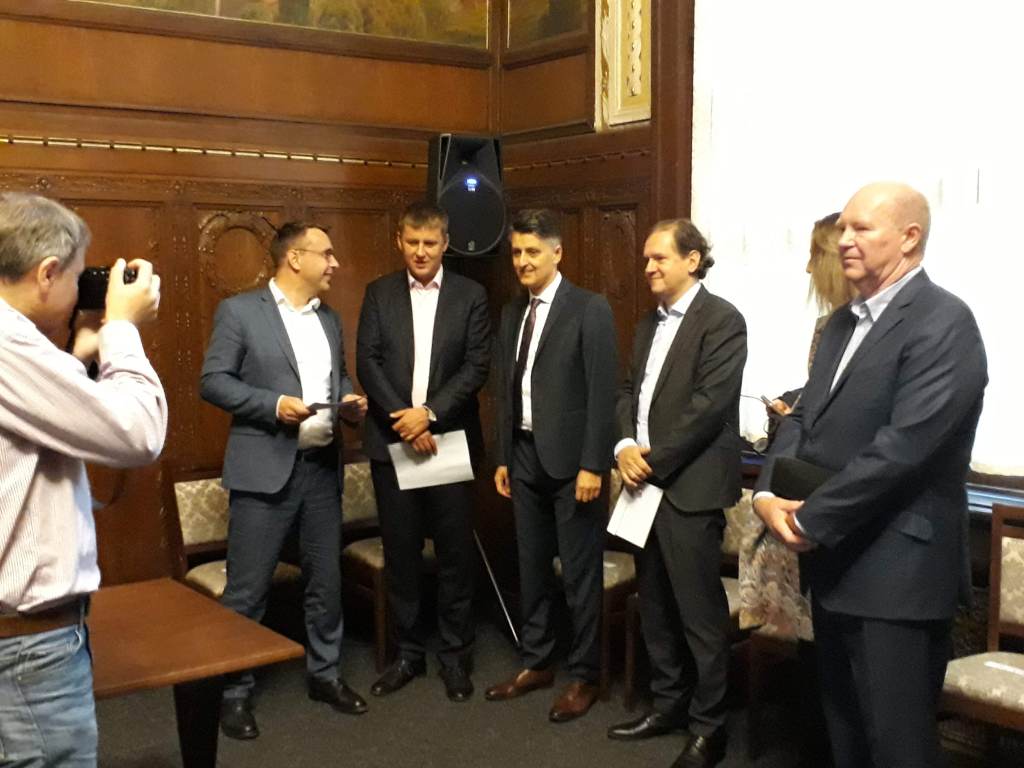
I am not sure if it was an indirect consequence of attending our ceremony, but Vladimír Kremlík got himself into big political trouble that morning. Karel Gott, a popular singer, had died and the public outpouring of grief in the Czech Republic was almost akin to that in the UK when Princess Diana had died. Karel Gott’s state funeral was to be the next day and he was having a lying in state in Prague on the day the Chess Train left. Thousands of people had queued overnight to be able to file past the coffin when the lying in state opened at 8am that morning. It appears that Kremlik used his position to queue jump and incurred the wrath of his Prime Minister, who said that his actions were unacceptable. Three months later Kremlik was sacked after being implicated in a financial scandal.
The formalities went on for rather longer than usual this year, and after a fairly rushed players’ briefing it was time to board the Chess Train which had conveniently pulled in at the platform alongside the Government Lounge.
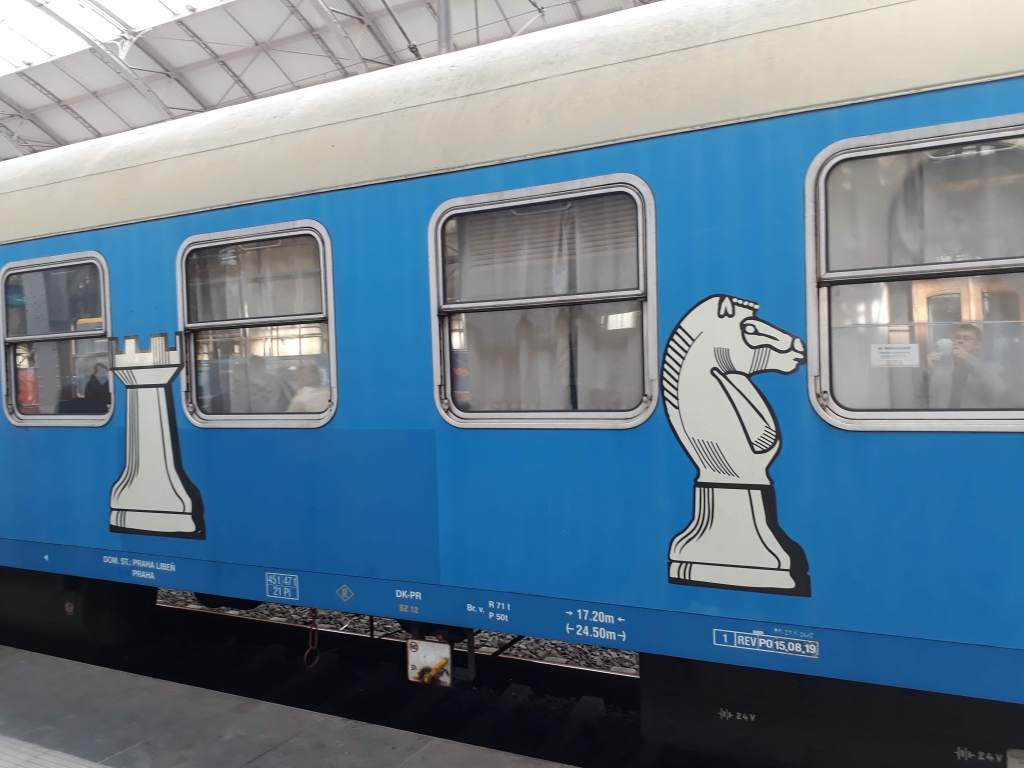
We initially headed north from Prague and travelled along the banks of the Elbe before turning west and making our way to Karlovy Vary. In the two rounds this day, I played a strong Dutchman and a strong Czech, losing both games.
We arrived in Karlovy Vary in the mid-afternoon. The station was a little way from the town centre and I was joined for most of my walk to my hotel by a Czech participant who was staying in a hotel nearby. Shortly, after I left him I walked past a mass of flowers and candles which had been left by the citizens of Karlovy Vary in memory of Karel Gott. My hotel was rather more old-fashioned than ones I had stayed in on previous Chess Train trips. I was allocated a room on the top floor, which was reached by a rickety double-gated lift. My room looked like it had been carved out of the attic as it was long and thin with a sloping ceiling. There was a bed at one end of the room and an armchair at the other. There was also a television in the middle of the room, but bizarrely nowhere where you could sit to view it.
As is my usual practice, I dumped my bags and set out to explore as quickly as possible. Karlovy Vary was unlike any another town in the Czech Republic that I had been to before. Architecturally it looks more Germanic than Czech, and judging by the language of the adverts around the place it caters for a large contingent of Russian tourists. I made my way to the Karlovy Vary Museum on the other side of the Ohře river from my hotel. The museum explained the changing ethnicity of the city. It was an overwhelmingly German-speaking part of the Austrian Empire up until World War I. After the war, much against the wishes of its citizens, it was incorporated into the new country of Czechoslovakia. As part of the Sudetenland, it was the first part of Czechoslovakia to be annexed by Nazi Germany. After World War II, ethnic Germans were expelled from the city. The museum also had lots of information about the mineral water and spas the city is famous for. The museum explained that the waters are sought after for their purgative effects – so I made a mental note to ensure that I did not drink too much of them.
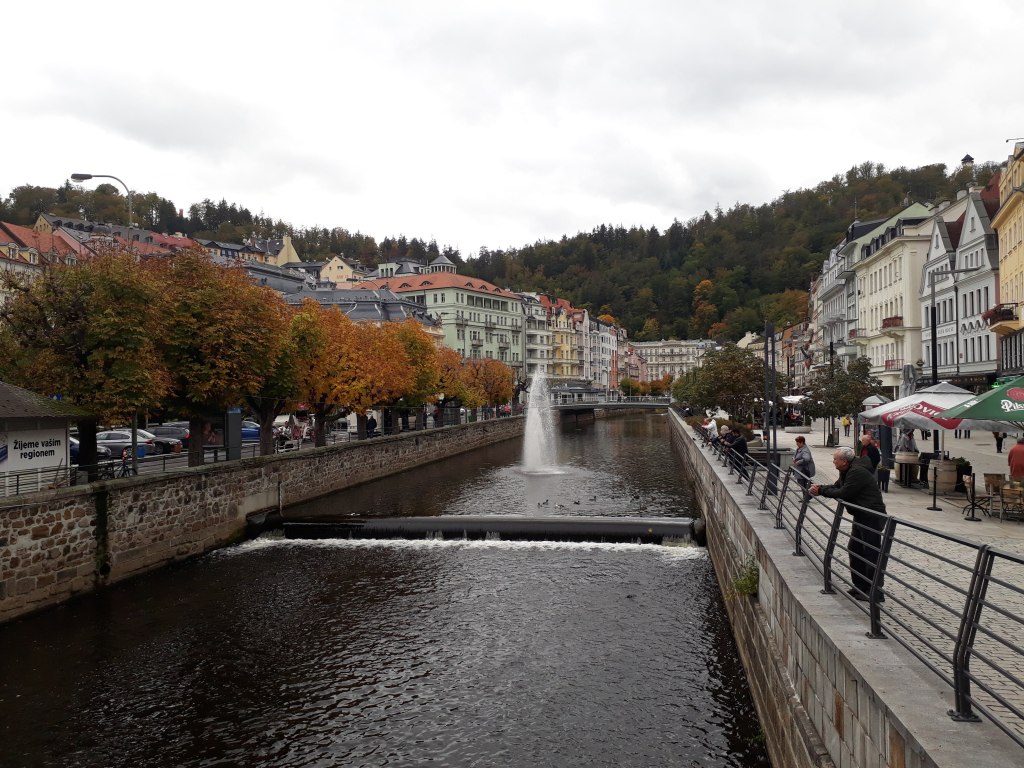
For dinner that night I chose a restaurant a little way from my hotel. I made the mistake of letting Google maps plot me a walking route, as though it may have seemed the shortest way to get there it ascended and descended two very steep hills, so it was certainly not the quickest. In the restaurant I had mixed meat kebabs, which were tasty, though a little pricey by Czech standards. I was also slightly disappointed that despite advertising a wide range of different beers, the restaurant only had one available on draught that night.
After leaving the restaurant I decided to walk back following the valley floor, which was much quicker. I then toured the hot spring colonnades to sample the waters. Many people were using decorated flat ceramic pots (which the local shops would happily sell you) to collect the water to drink, while others just used empty plastic bottles, as did I.
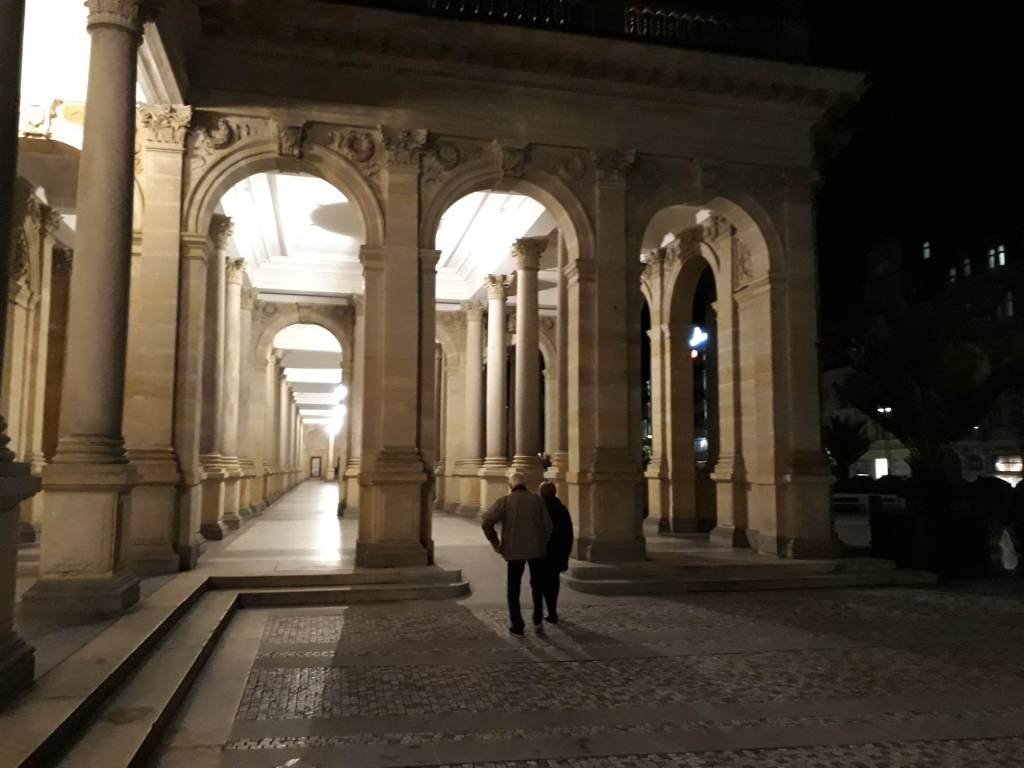
Saturday 12th October 2019 – Karlovy Vary to Český Krumlov
Another two rounds were played on the train today. I lost my first game to an American after crumbling in time trouble towards the end, but then beat in the next round a Czech man to whom I had lost the previous year.
Shortly after the second game had finished the train paused unwontedly and briefly in Pilsen (which I had visited in 1985), before moving on to České Budějovice where it had a longer stop. The reason for the halt in České Budějovice was that the line to Český Krumlov was not electrified, so locomotives had to be changed, and also that it is single track for much of the way such that the passing places were not big enough to accommodate the full length of the Chess Train. Consequently, most of the playing cars were to be left in České Budějovice and all the participants squeezed into the remaining carriages for the ride down to Český Krumlov.
We arrived in Český Krumlov in the mid-afternoon. Český Krumlov is a very picturesque town situated on a loop of the Vltava River dominated by its castle high on one bank. It has become a major tourist destination, although as it was considerably quieter in the evening and morning compared to when I first arrived, I got the impression that many visit it just for a day trip. My hotel was an historic building adjacent to the main square and I was allocated a very modernly furnished bedroom.
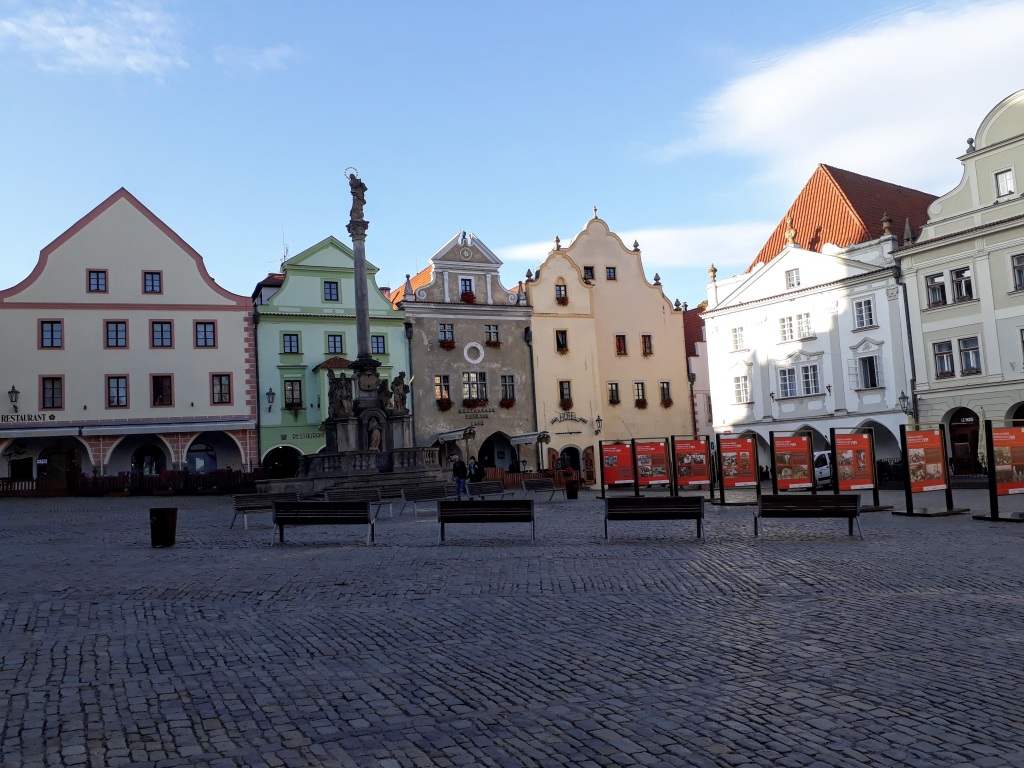
Although it was too late to go inside the castle, one could still wander about its courtyards. In the castle moat live some slightly forlorn looking bears.
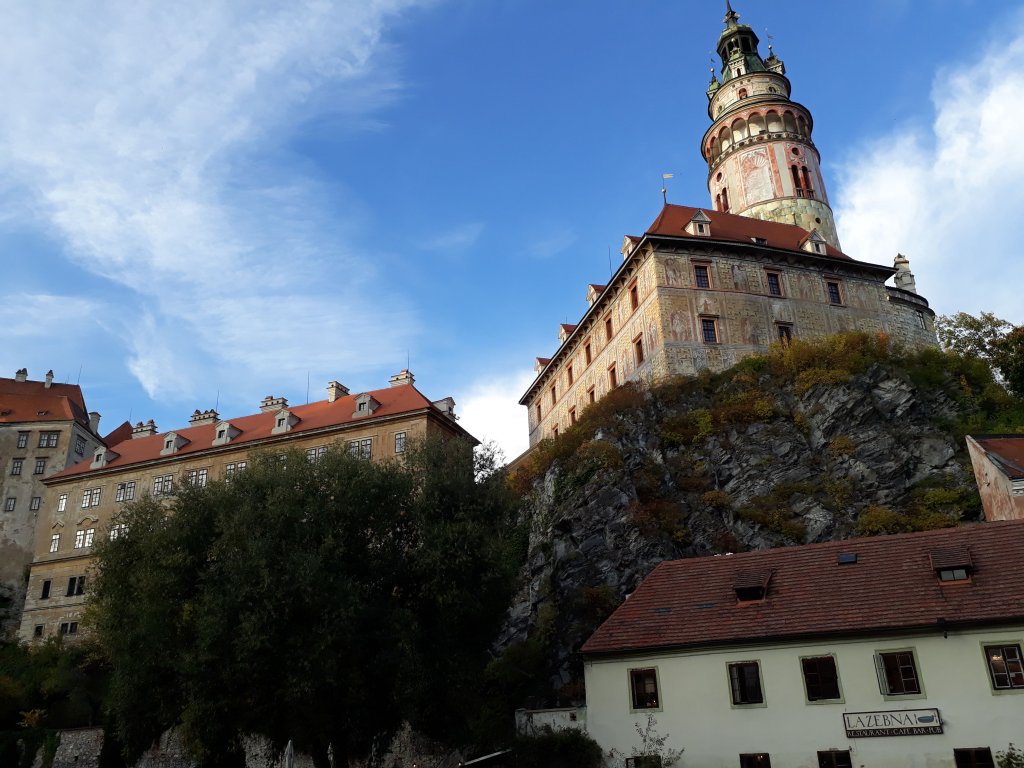
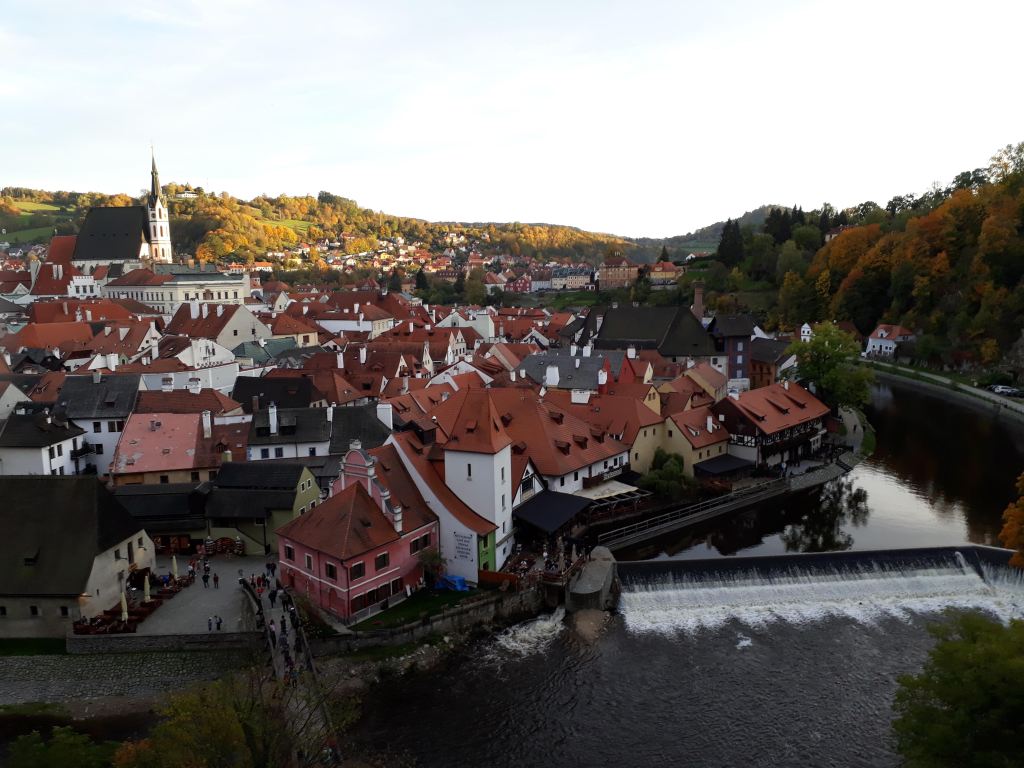
As is my normal practice I had researched somewhere to have dinner that night. The place I had chosen was a pub on the other side of the river from my hotel across the second of the two bridges from the town centre. However, when I arrived there the place was packed with no free seats and a band setting up to perform later. So rather than stay there, I explored nearby and was lucky to get a space in the restaurant of a guest house. The meal there was very good and I noticed that at an adjacent table were some other Chess Train participants, so after dinner I walked with them for a while to explore the town further.
Sunday 13th October 2019 – Český Krumlov to Brno
Today was a long day on the train travelling nearly the length of the country with three games played. But before the chess could start the train had to be reunited with the half of it which had been left in České Budějovice.
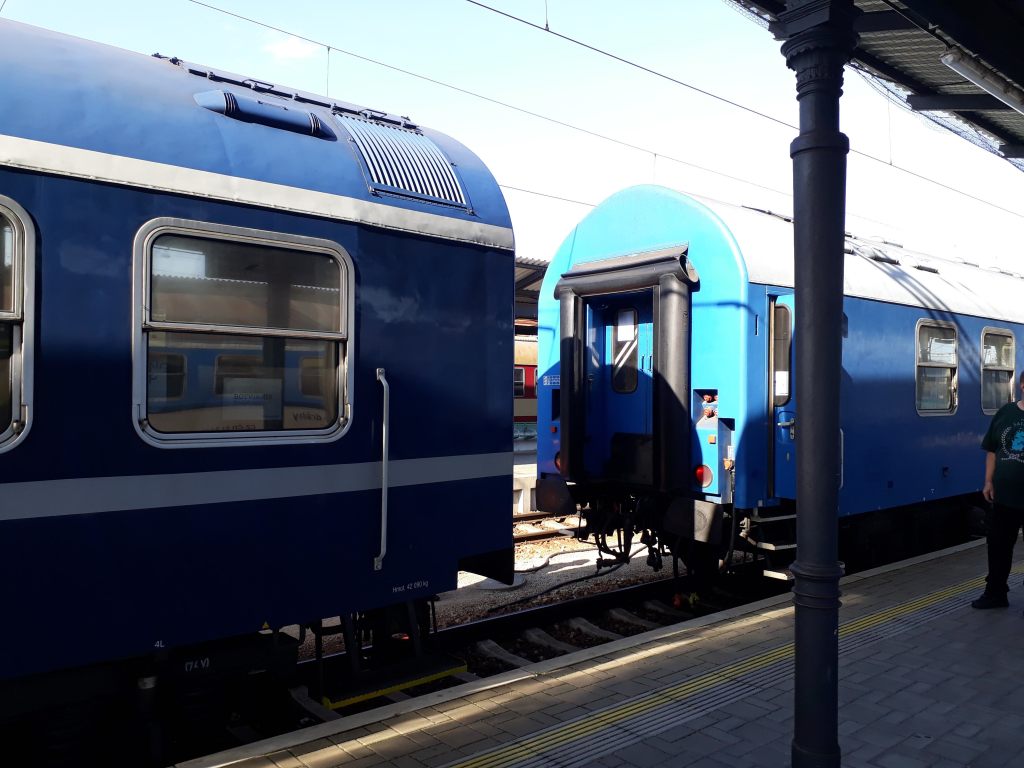
Once the train had been joined together we could find the correct playing car and begin our games – I then lost to a Czech man. After the first game there was a break for lunch. In the first game after lunch I played a blind German woman – I have experience of playing blind players, as one is a member of my current chess club. When playing a blind player moves are called out and you move the pieces on the board while they use their own special Braille board. My opponent fell for a trap in the opening and quickly lost a piece. Shortly afterwards it unfortunately became apparent that, possibly due to language difficulties, the positions on the two boards did not agree and my opponent thought that she could take my queen with her knight, but I had her knight on a different square. The arbiter was called, but there was no time to resolve the matter before the next round was due to start, so the game was declared as a draw. In the next game I beat an English man I had played the previous year. There was still a way to go until we reached Brno and we did not get there until about 5pm.
This was the first time that the Chess Train had visited Brno, the capital of Moravia, but it was my third visit, having been there in 1992 and 2017. We did not arrive at the main station but at Brno Dolní, a little way to the south of the city centre. I was familiar with Dolní as I had to use it in 2017, when Brno’s main station was shut for engineering work. Rather than joining the long queue for buses and taxis, I walked the short distance to the main station, partly through a shopping centre, where I bought tram tickets for my time in Brno. I used one of them to catch a tram to my hotel a little way from the city centre.
After freshening up at the hotel, I then caught another tram to the city centre to visit a restaurant I had eaten in on my previous visit a couple of years earlier. This restaurant had its own brewery and I was able to sample several of the beers it produced. I had ordered onion soup for starter, but the waiter forgot to bring it and I declined his offer to have it after my main course. After dinner I wandered around the city centre in the dark, revisiting some of the sights.

I caught a tram back to my hotel. When it reached the main railway station the tram filled up with ice hockey fans, who were returning from a match.
Monday 14th October 2019 – Brno to Trenčín
After breakfast I caught a tram back to the main railway station and walked the remainder of the way to Dolní. In previous years when departing from stations other than a city’s main station some participants have managed to go the wrong station. It appeared that everyone made it to Dolní and a full complement set off for the journey to Slovakia.
In my two games on the train today, I drew against a German man and lost to a Czech woman. As my second game was finishing I noticed that we passed through Bratislava. The train then proceeded to Trenčín where we arrived in the mid afternoon. Trenčín is a delightful Slovak city dominated by its castle which sits atop a large hill close to the city centre. The Chess Train had also visited Trenčín two years earlier, when I wrote about a rather chaotic guided tour of the castle.
I was staying in the same hotel, at the foot of the castle walls, that I had stayed in two years previously. This time there was not such a rush, as the castle’s scheduled opening hours had been extended compared with my previous visit. Nonetheless I did not delay and after leaving my bags headed straight to the castle. There had been some building work at the castle, as it had a new ticket office and visitors’ welcome area. There were not tours available at the time of this visit, but more of the castle’s interior was now open to be visited without a tour, including some parts which our tour failed to visit two years earlier (probably due to an unsafe number of people who had tagged along). This time I managed to get to the highest point of the castle building with splendid views of the city and beyond. While there I encountered a Frenchman from the Chess Train.
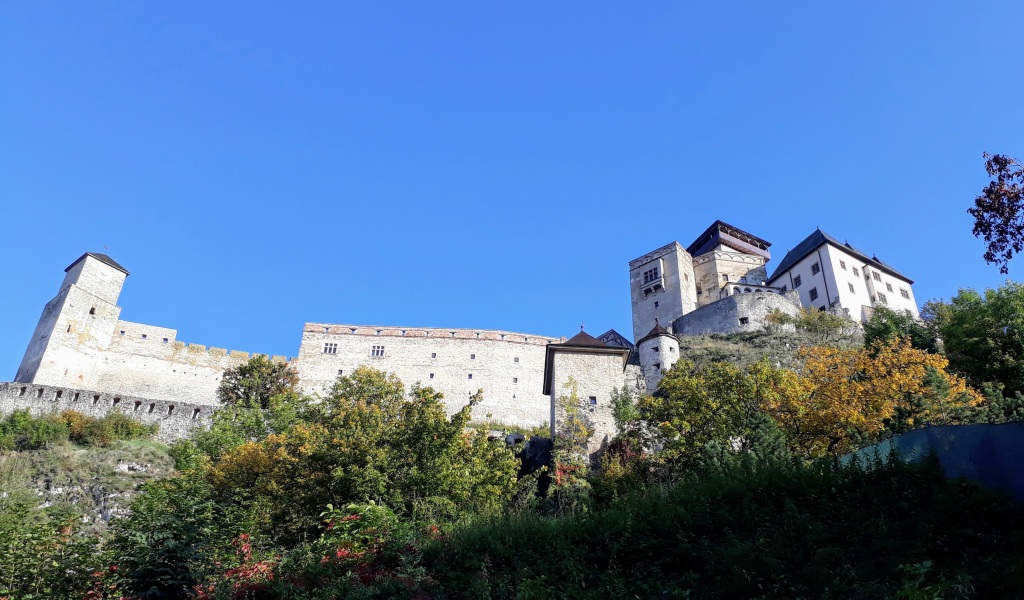
When I had finished exploring the castle, I went back into the town to visit Trenčín museum. The woman at the ticket office seemed very reluctant to sell me a ticket, possibly because it would mean she would have to leave her office to follow me around the museum. When the Frenchman I met at the castle also arrived seeking admission, she reluctantly gave in and sold us tickets, and then proceeded to keep a very suspicious eye on us as we looked around. The museum consisted of only a couple of rooms explaining the history of Trenčín and its surrounding area, so we did not keep the woman from her office for too long.
I then went for a stroll down the main pedestrianised street in the late afternoon sun, where people where sitting outside the cafes and bars having drinks. I bought myself an ice cream, admired the clock tower and gate (which reminded me of the one in Youghal, Ireland that I had visited a few months earlier), and called in at the information office where I collected some leaflets with information about the city.
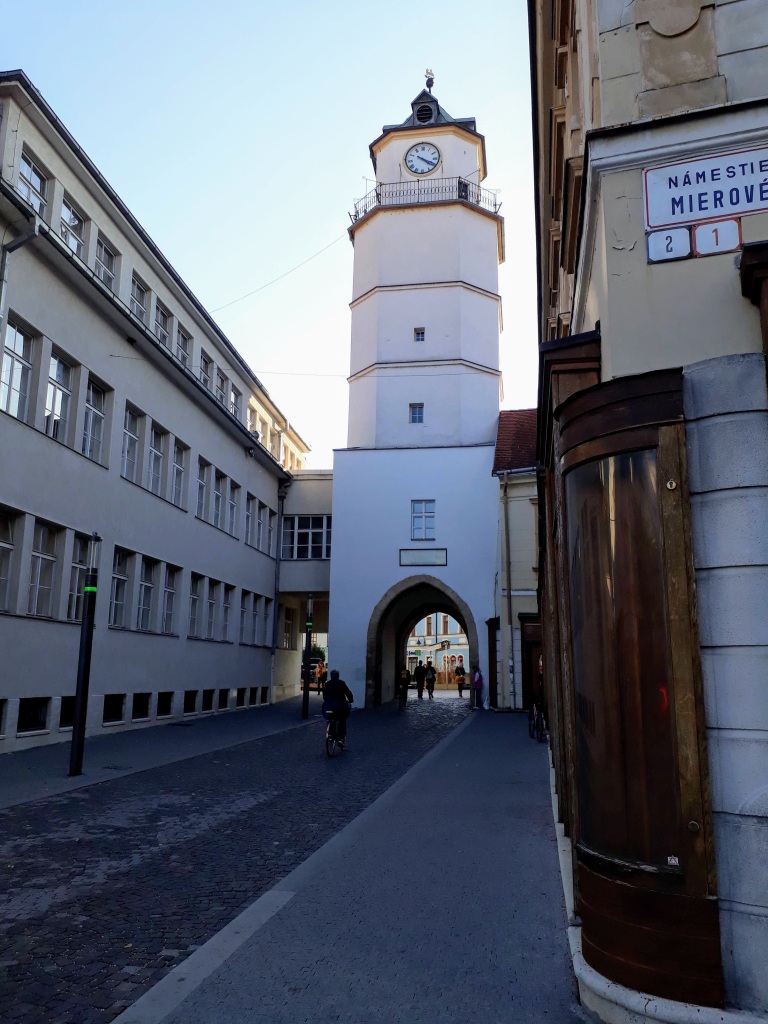
Upon my return to my hotel, I decided to visit the hotel’s swimming pool to get some exercise. A few lengths of the pool gave me an appetite for my dinner. I decided to go back to the Italian restaurant that I had been to on my first visit. The pasta starter I ordered turned out be a generous meal in itself and the the meat main course came in a rich sauce, so I was feeling distinctly full by the time I had finished.
Tuesday 15th October 2019 – Trenčín to Prague
This was scheduled to be another long day on the train, as rather than taking the main line back to Prague, the Chess Train travelled on a more circuitous northerly route via Olomouc. Two games were played – I lost the first to a German man, in a game I thought I was doing well in until I misplayed the endgame followed by a final round win against another Czech.
After the games had finished, the train stopped briefly in Olomouc to allow some people who lived locally to get off and so that others who needed to get back to Prague earlier could catch a fast train.
In the afternoon, I got myself a beer from the dining car and retired to an empty compartment, as I needed to try to phone my airline as there seemed to be a mistake about my confirmed hold luggage for my flight back the next day. This was eventually resolved and I settled back to enjoy the ride back to Prague.
However, when we reached Nymburk, about an hour from Prague, the train stopped and we were told that because the locomotive had developed a fault we would have a lengthy wait while a replacement was sent. I think strings were pulled in high places, because after a little while the locomotive from a passing freight train was commandeered to pull us back to Prague, where we eventually arrived at about 1745.
As I went to get off the train as we pulled into Prague’s main station, I realised that I was standing next to David Navara, the Czech Republic’s top Grandmaster who was to be the guest of honour at the closing ceremony. (I assume that he got on the train when it stopped briefly in Olomouc earlier.) As usual there was a wine reception in the Government Lounge where the prize-giving and closing ceremony took place. I was reassured that after doubts about the future of the Chess Train, the organisers were confident about it running again in 2020 (which, of course, sadly could not happen). Due to our late arrival the closing ceremony was slightly truncated compared with previous years. I had only scored 4 points out of 11 this year, a slightly disappointing performance, but I had enjoyed the experience just as much as ever. This year I had not played the wide range of nationalities I had encountered in previous years – in total I played five Czechs, three Germans, a Dutchman, an American and an Englishman. I went round the room one last time giving my farewells and saying that I hoped to see everyone again in 2020. As I went back to my hotel, it was already dark in Prague.
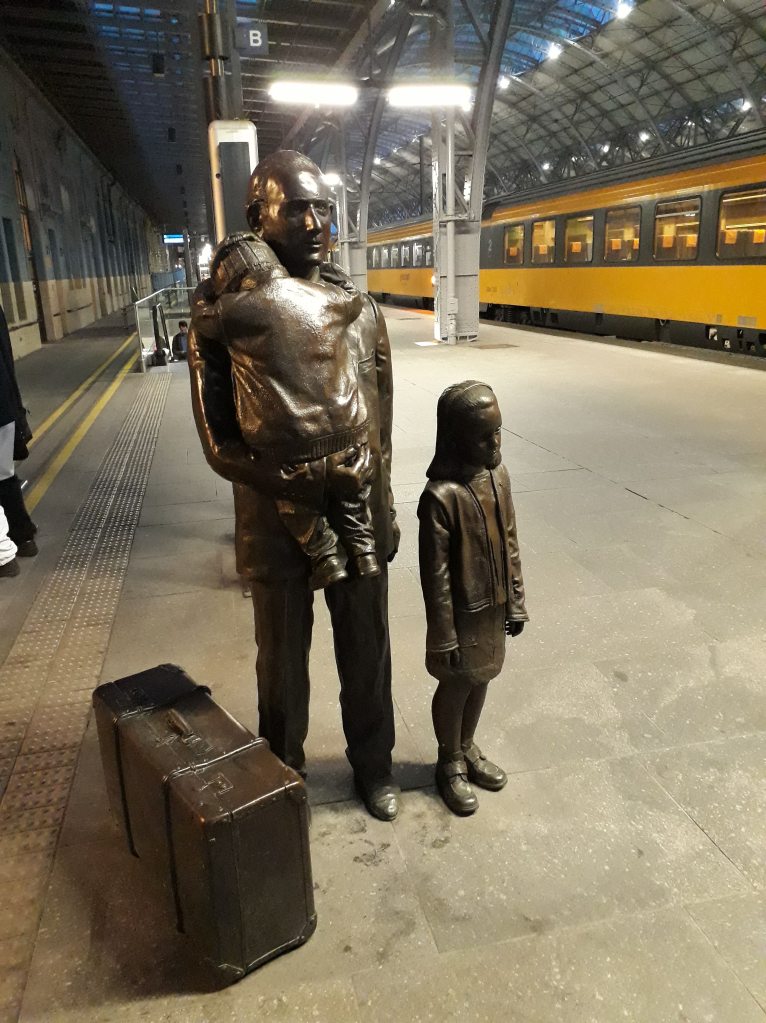
After checking in to the hotel, I went straight out to find dinner at the establishment I had used on my first evening. Unfortunately, when I got there the place was full and there would be a long wait for a table. I had spotted a different restaurant on my way there that I had not noticed before, so I tried that one and had a very good final evening’s dinner, which was cheaper and probably better than that I would have had in my original choice.
Wednesday 16th October – Prague to London
As my flight back to London was not until the afternoon, I had a spare morning in Prague. I got up early, so that I could visit the Strahov Monastery, which opened at 9am. I caught a tram to the north of the city. Opposite the stop where I got off was a statue of Tycho Brahe and Johannes Kepler. Brahe and Kepler had briefly collaborated in Prague prior to Brahe’s sudden death in 1601. After Brahe’s death, Kepler used Brahe’s observations to help formulate his three laws of planetary motion.
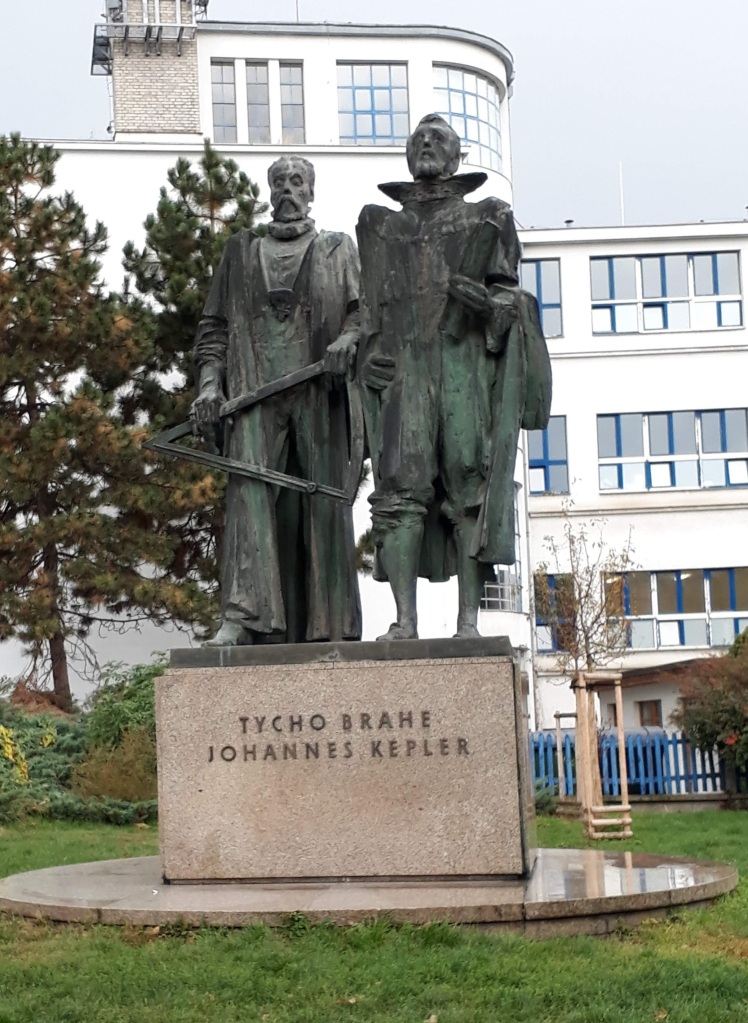
The Strahov returned to being a working monastery in 1990 after being shut down during communist rule. I first went to the picture gallery, which has has an extensive collection of art on two floors in four corridors surrounding a courtyard. I was the only visitor during my time there, though occasionally a monk would emerge from a side door and walk down a corridor. I then went round the corner to visit the Strahov Library. This seemed to be much more on the organised tourist circuit and when I arrived there were already a number of tour groups visiting. There are two impressively decorated halls – the Philosophy Hall and the Theology Hall – connected by a corridor containing a cabinet of curiosities. Unfortunately, due to conservation reasons, you cannot enter the halls, but only look in on them from the connecting corridor.
From the Strahov monastery, I walked a short distance to the Loreta, a place of pilgrimage since the 17th century, which contains a church and other buildings located round a large cloister. I purchased an audio guide to help me understand more about the place. By the time I had finished at the Loreta it was late morning, which meant I had to catch a tram back to the city centre to collect my luggage, before heading out to the airport for my flight back to London.
I was returning to City airport again and the plane approached the airport from the east by flying down the Thames. Security and baggage reclaim were very quick and I was back home little more than half an hour after landing. I discovered that the padlock that I had on my case had disappeared when I reclaimed it – I can only assume that it was removed with bolt cutters as a security check by Prague airport.
The 2019 Chess Train had been just as enjoyable and well organised as the previous two I had been on. I was already looking for forward to the special 2020 edition of the train, extended to six days to celebrate its 10th anniversary, but sadly it was not to be.
